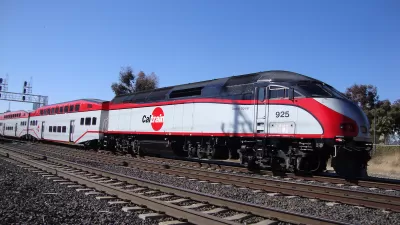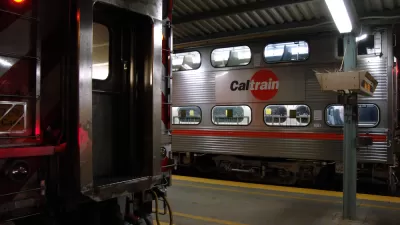Electrification of the Caltrain will be great for train riders, the environment, air quality, and public health, but it might worsen traffic congestion between San Jose and San Francisco by increasing the frequency of commuter trains.
Motorists stuck behind closed train gates may not be happy to hear that wait times may increase as a result of Caltrain electrification. It's not due to the trains themselves—as electrified trains will travel faster than diesel-powered trains due to speedier acceleration and deceleration; rather, it's that Caltrain will be running more trains, which means more "down time" for those gates.
Consequently, "seven of the 82 intersections between San Francisco and San Jose would see 'significant and unavoidable' impacts, according to a final environmental impact report prepared for the project," writes Jason Green of the Bay Area News Group.
The Peninsula Corridor Electrification Project is part of a $1.5 billion Caltrain Modernization Program that includes positive train control. "It will enable Caltrain to boost its ridership from roughly 60,000 today to more than 110,000 by 2040, according to the agency's projections," writes Green.
The only additional benefit to the program listed by Green is that it "is also expected to 176,000 metric tons of carbon dioxide from the atmosphere." The remainder of the article is devoted to increased congestion at particular grade crossings in Palo Alto, Mountain View, Sunnyvale and Burlingame.
The increased congestion is listed in the newly released Final Environmental Impact Report (FEIR) for the project, a requirement of the California Environmental Quality Act, or CEQA.
One solution is to build grade separations, but "Caltrain said the price tag was too high," writes Green. "Constructing grade separations at each of the seven intersections would cost between $350 million and $700 million."
"While grade separations are a technically feasible way to reduce traffic impacts at the at-grade locations, it is a highly expensive mitigation strategy," the report said. "Thus, Caltrain cannot commit to a comprehensive program of grade separations at this time to address all significantly affected intersections and this impact is considered significant and unavoidable.
Hat tip to MTC-ABAG Library.
FULL STORY: Report: Caltrain electrification to cause 'significant and unavoidable' impacts at certain intersections

Study: Maui’s Plan to Convert Vacation Rentals to Long-Term Housing Could Cause Nearly $1 Billion Economic Loss
The plan would reduce visitor accommodation by 25,% resulting in 1,900 jobs lost.

North Texas Transit Leaders Tout Benefits of TOD for Growing Region
At a summit focused on transit-oriented development, policymakers discussed how North Texas’ expanded light rail system can serve as a tool for economic growth.

Why Should We Subsidize Public Transportation?
Many public transit agencies face financial stress due to rising costs, declining fare revenue, and declining subsidies. Transit advocates must provide a strong business case for increasing public transit funding.

Alabama: Trump Terminates Settlements for Black Communities Harmed By Raw Sewage
Trump deemed the landmark civil rights agreement “illegal DEI and environmental justice policy.”

Dear Tesla Driver: “It’s not You, It’s Him.”
Amidst a booming bumper sticker industry, one writer offers solace to those asking, “Does this car make me look fascist?”

A Visual Celebration of Manhattan’s Chinatown Elder Community, Through Food
Lanterns, cafeteria trays, and community connection take center stage in this stunning photo essay.
Urban Design for Planners 1: Software Tools
This six-course series explores essential urban design concepts using open source software and equips planners with the tools they need to participate fully in the urban design process.
Planning for Universal Design
Learn the tools for implementing Universal Design in planning regulations.
City of Santa Clarita
Ascent Environmental
Institute for Housing and Urban Development Studies (IHS)
City of Grandview
Harvard GSD Executive Education
Toledo-Lucas County Plan Commissions
Salt Lake City
NYU Wagner Graduate School of Public Service




























